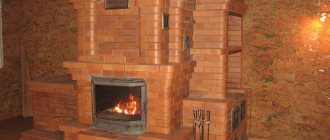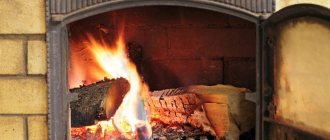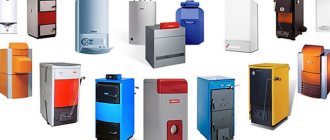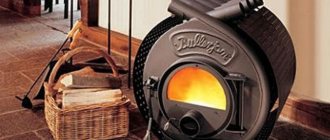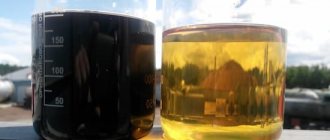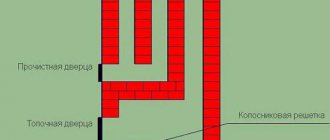People often wonder how houses are heated in Finland, since it is cold there most of the time. Russians spend a lot of money on heating their homes, maybe we just need to follow the example of the Finns. In Finland, gas or electric boilers are rarely used; they are mostly heated with wood.
Homes in Finland are renowned for their comfort, even on harsh winter days. Most of these houses take energy for space heating from the ground. Finnish rocky areas are considered natural radiators, and if you install a heat pump, you can get heat from the depths of the earth. This heating has only one big disadvantage - the price of the equipment, but it pays for itself in just 4 years and allows you to significantly save energy on heating.
Stove in the house
To understand why Finnish houses are so warm, you need to know how houses are built in Finland. They are framed and modular, and most often they are made of wood. Even the supporting beams are made of wood.
This does not mean that throughout the country there are only wooden houses. They are decorated with other materials to make them look like modern homes. Most often, Finns heat themselves with wood. Most often, the stove is made of soapstone. It is also called soapstone and it retains heat very well.
The uniqueness of these stoves is that the material quickly absorbs heat and gradually releases it to the room. Despite the fact that it is a stone, it does not cool quickly, but gradually. This material is used for the construction of saunas, it is involved in the decoration of walls and floors.
Some Finnish factories even use it for dishes. The Finnish stove is very similar to the Russian one. You can not only throw firewood in it to warm the room, but also for baking bread.
Unlike Russian stoves, there are several large factories in Finland that produce Finnish stove heating. Over the many years of work, a defect has never been detected. The most famous manufacturer is Tukikivi. The stoves of this company are widely known in Russia. The high cost prevents Russians from purchasing such equipment, although everyone understands that there is nothing good to expect from a cheap product.
Review of the most popular manufacturers of Finnish stoves
Let's take a quick look at the features of the most popular Finnish manufacturers.
Kastor Company (Castor)
Kastor stove
A special feature of this manufacturer is the production of furnaces made of heat-resistant steel with a thickness of 5-8 mm. The popularity of Kastor in the Russian market is due to its very high efficiency. This figure reaches 70%, which is much higher than other manufacturers in the same price category. All models of “Castor” stoves are coated with fire-resistant paint, which significantly extends the service life, and the manufacturer makes the doors from fire-resistant glass that can withstand temperatures up to 8000 C. The economic feasibility of the device is ensured by a complete fuel combustion system. And the air exchange system patented by Kastor significantly increases the efficiency of heating the room.
Kastor
A special burn protection system in the form of a fence is responsible for safe operation here. A well-thought-out ventilation system allows you to quickly warm up the room. The average price range of this Finnish manufacturer is 25-35 thousand rubles, but can vary significantly depending on the size and design of the device.
HARVIA company (Harvia)
Harvia oven
This Finnish manufacturer is in no way inferior in popularity to the Castor company, and many Russians have long associated the HARVIA brand with reliability and durability. The company chooses high-grade stainless steel as the main material for the production of heating devices, and a design feature is a remote firebox.
Another model of the Harvia stove
Such stoves heat the room very quickly and efficiently, are easy to clean and do not pollute the environment. All models have a fire-resistant cast-iron door and a body painted with fire-resistant paint.
A design feature of this company is the presence of two independent heating channels in all models. This approach allows you to increase the speed of heating the room, which significantly saves fuel. Narvia stoves are an excellent choice not only for heating a summer house, but also for a bathhouse.
You can buy a Finnish stove of this brand in Russia for an average of 25-40 thousand rubles.
Narvi Company (Narvi)
Narvi oven
A feature of this manufacturer is low fuel consumption. Just two loads of firewood and no more than 60-70 minutes are enough to heat a large room to 80 degrees Celsius.
On the Russian market today you can find more than 30 models from this company with long and short fireboxes. Regardless of design and size, all Narvi stoves are distinguished by high reliability, economical fuel consumption and long-term operation.
The average price range of this Finnish manufacturer is 12-20 thousand rubles.
Firm Helo (Helo)
Helo oven
Heating appliances of this brand are affordable, which does not in any way affect their high quality. The low price is due to the simple design. This option is ideal for a summer house, bathhouse, or small country house.
As for the technical characteristics, Helo stoves have excellent performance; they can warm up a large room in 1.5-2 hours and retain heat for a long time. There is a large assortment of this brand on the Russian market, which will make it easy to choose the appropriate unit.
Tulikivi Company (Tulikivi)
Tulikivi oven
This is one of the world's most famous manufacturers of Finnish stoves. A special feature of this company is the production of stoves made of natural stone. This is mainly soapstone (stone of volcanic origin).
The company offers two options for stone processing: grinding and chipping, which allows you to select the desired model according to the design and successfully fit it into the style of the interior.
Heating in Finnish style
Heating using Finnish technology is popular all over the world. Soapstone stoves are durable and perfectly warm even large rooms. The system is unique in that the stove consists of separate blocks that create a single structure that goes into the chimney.
Finnish manufacturers provide a quality guarantee, and each stove has its own passport, which guarantees twenty-five years of continuous operation.
In Russia, stove heating is not very welcome, because it considers it neither reliable nor safe. These furnaces have high efficiency and meet all fire safety requirements. It is also interesting that these stoves are installed in the very center of the house, which eliminates the need for additional heating of the room.
Bathrooms and toilets are built next to the stove heating, which immediately allows the water pipes to be heated. In addition, this allows the pipes not to freeze, which is very important in harsh climates. The Finnish stove consists of several arrays, which allows heat to be supplied to other floors if the house is several tiers.
Now it’s clear what they use to heat houses in Finland and why a Finn’s house is always at a comfortable temperature. But there is one drawback to this stove: you cannot turn it on when you leave home for a long time.
In this case, electricity is used in Finland. Moreover, a soapstone stove cools down completely only after two days, so if you leave the house for no more than 2 days, you don’t have to worry that the pipes will freeze and the room will have sub-zero temperatures when you return.
How to choose the right Finnish stove for your cottage
A wide range of models from Finnish manufacturers presented on the domestic market allows you to choose a wood stove not only for heating your dacha, but also for cooking, heating water, and just admiring the fire. To make it easier for you to decide on purchasing a Finnish stove for your country house, we suggest that you familiarize yourself with the main selection criteria.
- Power.
The choice of this criterion is determined by the overall cubic capacity of the room. To do this, we make simple mathematical calculations: we multiply the area of the room by the height of the ceilings. In addition, make a “margin” for the thermal insulation of the house. After all, the worse it is insulated, the more powerful the device you will need. Keep in mind that every doorway and window increases heat loss by 100 watts. If the dacha is located in a climate zone with severe winters, then multiply the resulting figure by 1.5-2 units.
- Operating time in temperature maintenance mode. Pay attention to the material from which the product body is made. This parameter depends on this factor. As a standard, solid fuel must be added to the firebox every 8-10 hours. But some models lined with volcanic stone can retain heat for 20-24 hours. Today you can find long-burning wood heating appliances on sale. These models are equipped with a fireproof glass door, which ensures maximum tightness. Due to the fact that oxygen does not enter the firebox, the burning intensity of the flame increases significantly.
- Size. One of the main criteria for choosing a Finnish stove for a summer house here will be the width of the firebox. The diameter of a heating device with a power of 100 kcal/hour must be at least 12 cm. The maximum permissible level is 50 cm.
- Additional designs.
It all depends on the purpose for which you are purchasing a stove for your summer house. If you want to limit its functionality to heating only, then simple models equipped with one firebox will be enough for you. If broader functional use is expected, then you can take a closer look at models with a flat hob, which is located in the upper part of the stove.
Some models come with a water heating tank, which is installed directly in the stove body. Or you can look for a model with a hinged type of device that is mounted on the chimney.
- Appearance. If cast iron and steel are not your thing, then you can choose stoves whose body is made of soapstone. This stone was traditionally used as a building material among the Scandinavian peoples, due to its unique properties. This is a type of stone cladding that not only has a magnificent appearance, but also does not heat up above 70 degrees. This significantly increases the comfort of use and safety in the home. Talkomagnesite conducts heat 10 times faster than fireclay bricks or ceramics, which means that with a much smaller oven, it will warm up the room faster.
Another natural material that Finnish manufacturers began to use in solid fuel stoves is soapstone. It is highly resistant to temperature, withstanding up to 16 thousand 0 C. Furnaces made of soapstone can heat up in just 2 hours, while they continue to give off heat to the room for another day after being turned off. The only caveat is that the effectiveness of a device made of such material largely depends on its size. To achieve high heating efficiency, manufacturers produce large models, which significantly affects their price.
- Manufacturer. The Russian market offers a huge variety of wood heating appliances from Finland. All of them differ not only in price, design, but also in technical characteristics.
What is the difference between Finnish heating and Russian
The Finnish heating system is distinguished by the fact that it does not have a coolant. This eliminates the worry about pipes. The heat is accumulated by the stove itself, and this heat is enough to provide a large room, even several floors. These functions are beyond the capabilities of any boiler. Only a Russian solid fuel boiler can compete with it, but you need to constantly add firewood to it, and this is inconvenient.
Russians most often heat their homes with gas or electricity. Both of these methods are very expensive and people have to pay about 100 euros during the winter month just to keep their house warm. People who live on land sometimes install wood-burning stoves, but in this case the residents even have to get up in the middle of the night to add wood to the firebox. It is not comfortable.
In Russian villages, electricity costs less than in the city. Therefore, those people who do not want to spend money on a wood stove buy electric boilers. In any case, the Finnish heating method is becoming more and more popular every year. Since there is demand, then maybe there will be more offers, and prices will drop a little so that a Russian person, even with a small income, can install such heating.
Heat-intensive Finnish stoves are the main source of heat in Finland. The house is heated when there is a need for it. Remember that a warm home can only be ensured by high-quality stove heating.
The stove still provides warmth
Solar panels produce energy even in Finland. Photo: Niko Nurmi/Tekes
The owner of his own home has the opportunity to significantly reduce his expenses. It’s much more difficult for residents of high-rise buildings: they are “hostages” of central (in Finnish, more precisely: remote) heating. What and how the house is heated is sometimes unknown to them, and it is difficult to influence it. Lighting and numerous household appliances are in your hands: there is intense competition between electricity producers. You can go to a special website, compare prices and choose the best one. Particularly adventurous ones in the pursuit of savings change electric companies every year.
About a hundred years ago, the only way to heat your own home was with stoves of various designs, and until now, in almost every modern cottage, a fireplace has its place of honor. However, the fireplace now plays a secondary role: it alone cannot heat a large house.
Until recently, a Finnish homeowner’s best friend could be called a boiler that was heated with fuel oil. Inconvenient, uneconomical and unecological, it is not yet forgiven: even now 20% of the Finnish housing stock is heated in this way. But owning houses is becoming less and less common, and new ones are never the case - paying extra money and spoiling the environment is not at all in Finnish customs. Today in Finland the law of two “Es” rules - economy plus ecology.
Adviсe. Recommendations
Warm Finnish houses are an example to follow. The Finns even developed a special refrigerator, part of which is located outside, and the heating system is in the house.
This design consumes only 1 kilowatt of energy per day and warms the house even at minus 30 degrees, and the heat pump will sometimes produce up to 5 kilowatts of heat. This system is not as popular as soapstone stoves, but many claim that they are the future and it is worth taking note of this information.
If you decide to change the heating in your house, then remember:
- you need to choose the right heating system. It is better to opt for a water system;
- choose a stove according to the dimensions of the room so that it is not too cold or too hot;
- When purchasing, pay attention to the power of the pumps.
Important! Build your house from quality material and insulate it well. This will save on heat production in winter.
A geothermal heat pump draws energy from the ground
Increasingly, a new Finnish house draws its energy, like the mythological Antaeus, from the earth. Indeed, in Finnish conditions, at a depth of 200 meters, the temperature can reach +10 degrees. Finnish rocks are like giant radiators: they accumulate heat in the summer and release it in the winter. Tubes are laid in the ground through which 40% ethyl alcohol circulates.
A special device is installed in the house: something like a reverse refrigerator with a computer built inside. It is, of course, not cheap, but it pays for itself in 5-7 years and allows you to save 30 percent of electricity or more. It is not surprising that such enviable figures seduce the owners of old houses, and they undertake to refurbish their homes.
Safety of Finnish fireplaces
The main distinguishing feature of Finnish wood-burning stoves for the home is their safety. It is achieved by completely isolating the fire from the external space behind the stove. Air saturation through the ash pan is carried out through insulated channels, and the chimney hermetically removes combustion products outside the living quarters.
In addition, the design is a solid metal form that is resistant to mechanical stress and destruction from heat. Brick stoves, for example, can burn out over time and collapse from the heat if laid incorrectly, while Finnish stoves are purchased and installed in a monolithic design.
Operating principle of heating stoves
As already mentioned, first firewood is placed in the stove and lit. The firebox is closed with a lining, and the wood begins to burn and the lining begins to heat up.
The air heats up from the lining, and then a physical phenomenon called convection begins. This is the specific ability of air masses to move, circulating around the room and displacing cold air masses. The movement occurs unnoticed by humans, and the room is gently filled with warmth.
Important! Some models are equipped with a water pipe for radiators. Their principle is to combine convection with heating water in pipes, which also heat the room.
